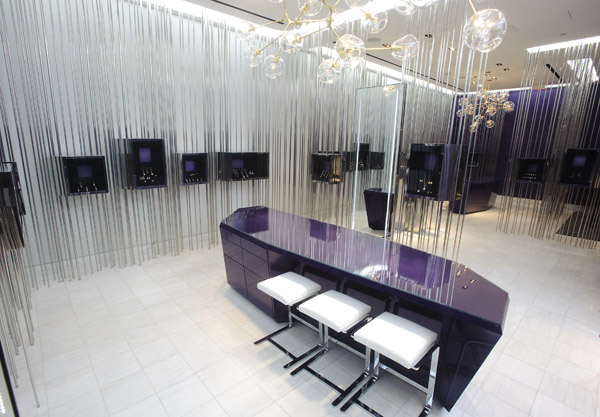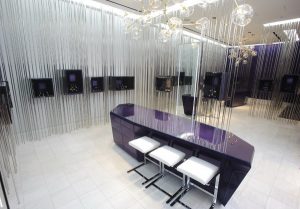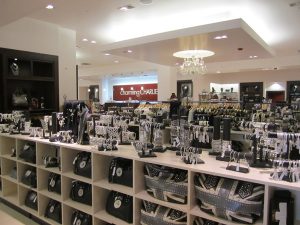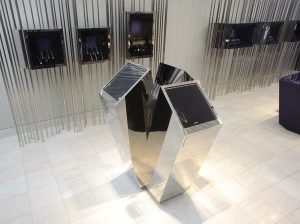If apparel, from fashion to ready-to-wear to cheap chic, has been slow to emerge from the recession, the accessories business is booming. And designer brands are driving the boom.
Housewares designer Jonathan Adler recently announced his entrance into the accessories business, converting his store in New York’s Greenwich Village into an accessories-themed emporium – with two more accessories stores slated to open this year, carrying the designer’s characteristically witty, whimsical touch on handbags, scarves, neckties, socks and small leather goods.
Italian fashion brand Valentino has opened an accessories-only store in The Forum Shops at Caesar’s, Las Vegas, the brand’s first of its kind in the U.S. (and second in the world).
Charming Charlie is doing for bags, bracelets and baubles what H&M and All Saints have done for apparel: inexpensive, desirable but disposable fashion items, growing in less than 10 years from humble Houston roots to a coast-to-coast empire of more than 250 stores.
Macy’s Inc. (Cincinnati) has made branded accessories a dominant element of its renovated first floor at New York’s Herald Square, a branded emporium of the big names – Coach, Michael Kors, Ralph Lauren, Dooney & Bourke, etc. – clustered at the flagship store’s main Broadway entrance.
In a difficult economy, accessories always represent an affordable way to refresh an outfit or possess a fashion label. Particularly today, the fashion apparel brands are aggressively expanding into accessories, especially at higher end, says Steven Derwoed, Macy’s vp of store design and merchandising.
Advertisement
“Every high-end fashion house is developing a handbag, perfume, a sunglass frame,” Derwoed says. “Manufacturers are going further into becoming lifestyle brands. Coach made handbags. Today, it’s men’s accessories, shoes, apparel, even jewelry.”
Derwoed notes that Ralph Lauren has created an accessories sub-shop inside its traditional vendor shop for its new line of men’s bags and other accessories.
If the hot new item today is iPhones, says Ken Nisch, chairman of JGA Inc. (Southfield, Mich.), an equally important accessory is the cover on the device. “Today, your accessories have accessories,” says Nisch. “Snap-on iPhone or Galaxy covers is a whole new sector of merchandise. Swarovski, Coach and Louis Vuitton are among the brands, and they can reach $200-$300.”
As designer brands extend their accessories offerings – to eyeglass frames, umbrellas and iPhone covers – jewelry is increasingly in their cross-hairs. David Yurman, Ted Muehling and Gurhan Orhan are as important brands to today’s shopper as Tiffany, Cartier and Harry Winston.
They’re all fighting for a piece of the $33 billion U.S. jewelry market, which is beginning to show signs of life again after five years of lackluster performance.
Some of the industry’s finest jewelry designers – like Temple St. Clair, Kara Ross, Amrita Singh and Ippolita Rostagno – whose treasures have sold in New York’s Bergdorf Goodman and Saks Fifth Avenue – are beginning to produce custom pieces for individual clients willing to pay five or six figures because the retail jewelry market has become somewhat fragmented.
Advertisement
“The world was collapsing, and the price of gold was astronomical, and people just weren’t buying jewelry,” Ross recently told The New York Times.
“I was down 75 percent,” Singh, who has been selling her collection at Bergdorf Goodman for about 10 years, said in the same article. Now, though both designers still show their fine jewelry collections in a number of stores, including Neiman Marcus, they also sell their less-formal costume jewelry on QVC, where Singh’s Bangle Bangle line, with pieces between $50 and $400, sold more than a half-million units last year.
“There’s an increasing awareness of designer brands in jewelry, just as there is in fashion and other items,” says Pam Levine (Levine Design Group, New York), a strategic branding consultant and visual merchandiser specializing in luxury, jewelry, fashion and home accessories. “Jewelry shoppers are increasingly looking for designer names.”
Bergdorf Goodman has an entire floor of its New York women’s store devoted not only to fine jewelry (gold, silver, platinum, diamonds and precious stones) but also to fashion jewelry – alternative materials, metals and gems. (In the 80s, its designer jewelry offerings were limited to two showcases.)
Barneys New York now offers fine, vintage, antique and fashion jewelry. ABC Carpet & Home, the Manhattan one-off home furnishings store, and Anthropologie, the craft-oriented sister of Urban Outfitters (Philadelphia), have extended their fashion jewelry offerings. Even traditional Tiffany (New York) has introduced a line of jewelry designed by architect Frank Gehry.
Tiffany is also reexamining its retailing approach, starting with the much more informal, more interactive store it recently opened in New York’s SoHo. “The store is light and inviting, and easier to get around and view the merchandise,” says Levine, “though it still sells fine jewelry, as it does on Fifth Avenue. But Van Cleef & Arpels, Harry Winston and Cartier also offer more everyday or day-to-evening wear instead of just the serious, important jewelry they offered in the past.”
Advertisement
Two by London, a division of venerable London Jewelers (Glen Cove, N.Y.), has opened a more casual and expansive, more interactive store in the upscale Americana Manhasset (N.Y.) mall, side by side with its parent London Jewelers, David Yurman and Cartier, in which first-time engagement ring buyers can design their own rings.
Hearts on Fire, the Boston-based diamond brand, has opened its first store, in Las Vegas, designed by Eight Inc. (San Francisco), which designed the first Apple store. “It’s very modern, almost high-tech,” says Levine. “It’s a good example of what’s happening in jewelry retail – different technology to better interact with the merchandise and provide an experience.”
This summer, Swarovski, the Austrian crystals producer, announced intentions to become the global leader in the fine jewelry segment, partly by expanding its Swarovski retail empire.
It has begun to test a new fine jewelry concept in China, where it has created Swarovski Fine Jewelry brand shops featuring dedicated architecture and specially trained staff.
“We want to find out whether Swarovski as a brand is able to credibly carry a fine jewelry line,” Robert Buchbauer, a member of the Swarovski executive board, told Women’s Wear Daily in August.
Swarovski isn’t the only group with big ambitions in fine jewelry. This year, Kering (the French multinational company formerly known as PPR) bought Pomellato of Italy for an estimated $360 million and Chinese jewelry brand Qeelin. The Swatch Group (Biel, Switzerland) bought Harry Winston for about $1 billion in January. In 2011, LVMH Moët Hennessy Louis Vuitton (Paris) acquired Bulgari (Rome).
It seems there’s a lot of accessories shopping going on, both in front of and behind the display counters.


 Photo Gallery2 days ago
Photo Gallery2 days ago
 Headlines1 week ago
Headlines1 week ago
 Headlines2 weeks ago
Headlines2 weeks ago
 Sector Spotlight2 weeks ago
Sector Spotlight2 weeks ago
 Headlines1 week ago
Headlines1 week ago
 Headlines4 days ago
Headlines4 days ago
 Headlines2 weeks ago
Headlines2 weeks ago
 Designer Dozen1 week ago
Designer Dozen1 week ago




















